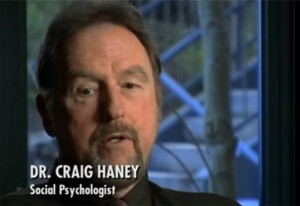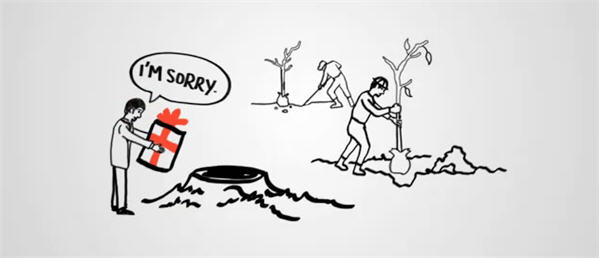![The Recipe For A Better World: 21 Billion Hours Of Online Gaming Per Week [TED Talk]](http://www.mutualresponsibility.org/wp-content/uploads/2012/09/recipe-for-a-better-world.jpg)
![The Recipe For A Better World: 21 Billion Hours Of Online Gaming Per Week [TED Talk]](http://www.mutualresponsibility.org/wp-content/uploads/2012/09/recipe-for-a-better-world.jpg)

Stanford Prison Experiment Shows How The Abuses At Abu Ghraib Could Be Perpetrated By Otherwise Good People
Dr. Philip Zimbardo, Professor Emeritus of Psychology at Stanford University, and who once conducted the now famous Stanford Prison Experiment, recently related the results of that 1971 experiment to the abuse discovered at Abu Ghraib. He said, When the images of the abuse and torture in Abu Ghraib were revealed, immediately the military went on the defensive saying it’s a few bad apples. When we see people do bad things we assume they are bad people to begin with. But what we know in our study is: there are a set of social psychological variables that can make ordinary people do things they could never have imagined doing.” The Stanford Prison Experiment was conducted over a six day period in a mock prison environment in the basement of one of the buildings at Stanford University. It demonstrated how ordinary people can perpetrate extraordinary abuses when placed in a cruel environment without clear rules, as shown in this short documenatry [13 min]. What Happens When You Put Good People In Evil Places? Dr. Craig Haney, a social psychologist participating in the Stanford experiment said of it, We frankly didn’t anticipate what was going to happen. We tried to really test the power of the environment to change and transform otherwise normal people. Much as Milgram had changed or transformed otherwise normal people in an obedient situation, we wanted to do it in a prison-like situation.” Experiment Participant Relates To The Guards At Abu Ghraib Dave Eshelman, who played the role of a prison guard in the Stanford University mock prison experiment, said of the Abu Ghraib prisoner abuse photos, What...
A Roller Coaster Ride Through The Industrial Age And Our Dependence On Fossil Fuels
“It’s all hands on deck” is the clarion call of the Post Carbon Institute in this fast paced 5 min. video, which takes us on a wild ride through the industrial age and our dependence on fossil fuels – culminating in the need for some tough changes to be made: If we do nothing we will still get to a post carbon future, but it will be bleak. However, if we plan the transition, we can have a world that supports robust communities of healthy, creative people, and ecosystems with millions of other species. One way or another, we’re in for a ride of a lifetime.” What Is The Solution? In short, the Post Carbon Institute recommends, we need to live within Nature’s budget of renewable resources at rates of natural replenishment.” They further suggest the following: Learn to live without fossil fuels.” “Adapt to the end of economic growth as we’ve known it.” “Support 7 billion humans and stabilize population at a sustainable level.” “Deal with our legacy of environmental destruction.” Do We Have A Choice? The Post Carbon Institute makes the following arguments: Alternative energy sources are important, but none can fully replace fossil fuels in the time we have.” “We’ve designed and built our infrastructure for transport of electricity and farming to suit oil, coal and gas. Changing to different energy sources will require us to redesign cities and manufacturing processes.” “We’ll have to rethink some of our cultural values . None of our global problems can be tackled in isolation and many cannot be fully solved.” “We have to prepare for business unusual.” Source of...
Dan Ariely, Prof. of Behavioral Economics, Seeks To Account For Human Nature
From a rational perspective, we should make only decisions that are in our best interest (“should” is the operative word here)… and choose the option that maximizes our best interests… Unfortunately, we’re not.” This is where behavioral economics enters the picture. In this field, we don’t assume that people are perfectly sensible, calculating machines. Instead, we observe how people actually behave, and quite often our observations lead us to the conclusion that human beings are irrational.” The above and subsequent quotes are taken from Dan Ariely’s book, The Upside of Irrationality: The Unexpected Benefits of Defying Logic at Work and at Home. Ariely is a Professor of Psychology and Behavioral Economics at Duke University and author of other works on behavioral economics. Standard Economics Vs. Behavioral Economics: A Matter Of Perspective? … there is a great deal to be learned from rational economics,” he says, “but some of its assumptions—that people always make the best decisions, that mistakes are less likely when the decisions involve a lot of money, and that the market is self correcting—can clearly lead to disastrous consequences.” Social And Market Forces The Financial Crisis … think about the implosion of Wall Street in 2008 and its attendant impact on the economy. Given our human foibles, why on earth would we think we don’t need to take any external measures to try to prevent or deal with systematic errors of judgment in the man-made financial markets?” This is where behavioral economics veers far from standard economics, because it seeks to look at human evolution and psychology in addition to standard economics, in order for social and...![Neuroscience Reveals: Your Consciousness Is Connected To Everyone Else’s [TED Talk]](http://www.mutualresponsibility.org/wp-content/uploads/2012/09/ramachandran.jpg)
